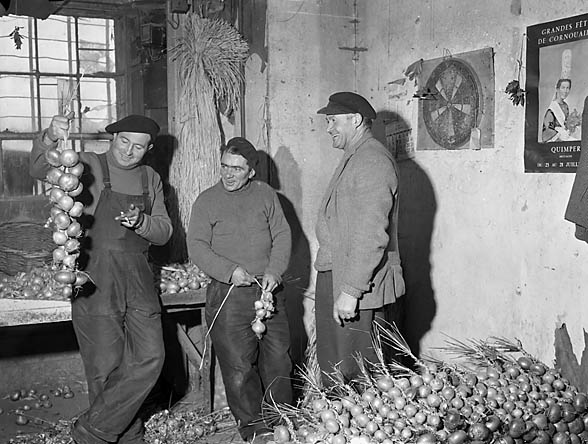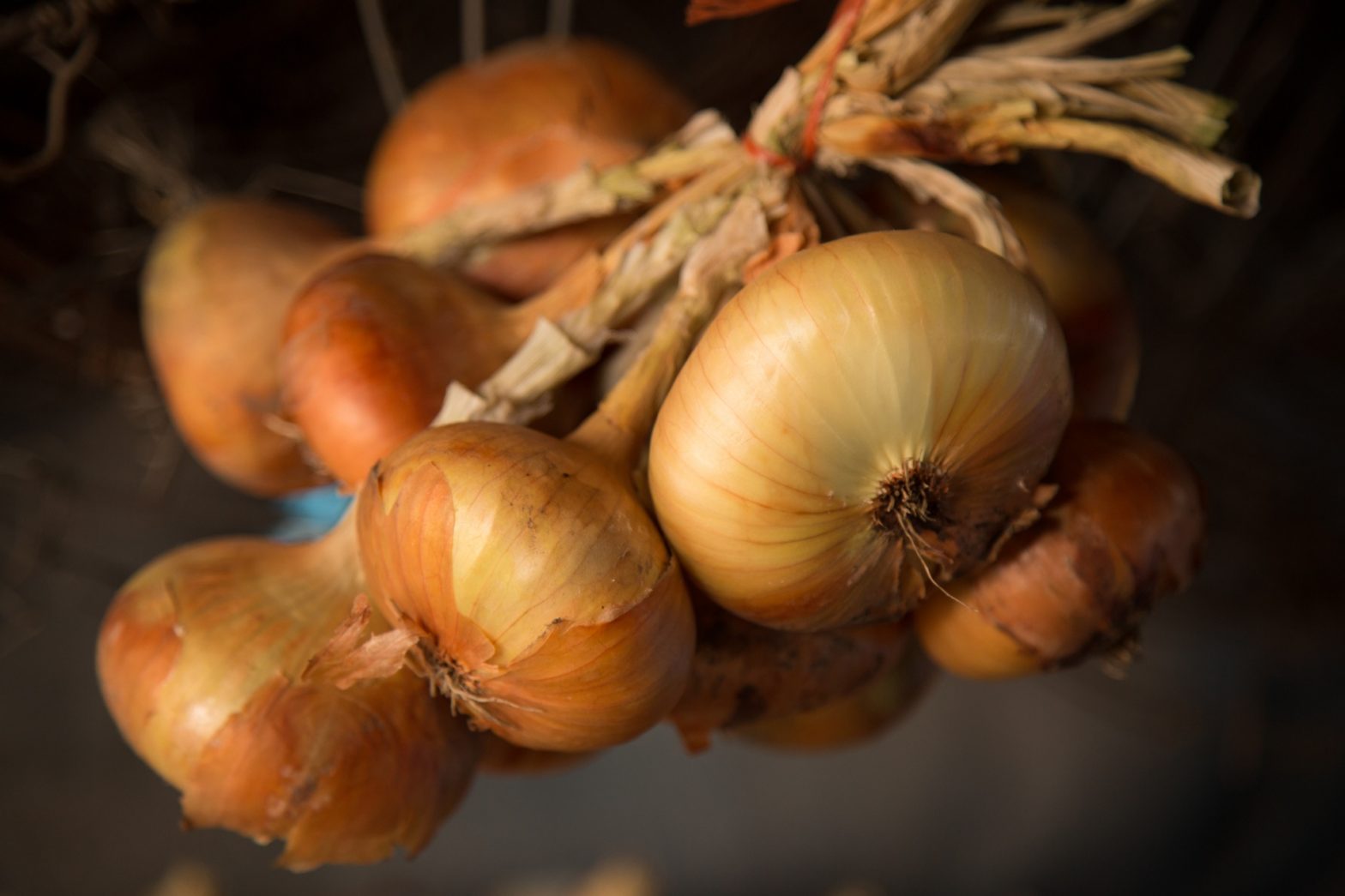This series of posts is exploring Welsh food culture, as it developed from the time of the earliest written records through to the 20th century. Much has changed in the last 50 years, so that only vestiges now remain of ways of growing, preparing and sharing food that had previously united much of the country in a shared dishes and culinary cultures. But though the past may be a foreign country, it contains much that is of interest, and perhaps of value…
It’s a fine early autumn day in Llantwit as I cycle the final approach into town in September 2010. People are milling around the string of small shops and a couple of older women are stood chatting to a man whose bike is leaning against a lamppost. I lock up my own bike and amble over; he is indeed wearing a striped shirt and his bike is laden with strings of onions. I’m delighted, and greet him in French. He’s a student from Britanny; yes, he’s been here a few weeks – there’s a small team of them with a base in Cardiff selling in the towns round about. This is one of the modern Sioni Winwns, selling Breton onions in Wales in an unbroken tradition extending back to the 1820s.[1]
I buy a string of onions from him, and present them to Mam when I get home that afternoon. She’s delighted; she hadn’t seen any Sionis in Cardiff yet that year, but the onions are so much better than the ones you get in the shops – sweeter, and they keep better. She remembers a previous generation of Sionis as a fixture of the Pontypridd streetscape in the 1970s. That generation was not composed of students, partly spending their time in Wales in order to improve their English. In fact, there were generations of Sionis selling in Wales who not only didn’t speak English, but were hardly able to get by in French either: these were bilingual Breton-Welsh market farmers, whose market just happened to be located several hundred miles of sea travel away.
—————————————————————
Sioni Winwns/ Ar Joniged/ Onion Johnnies: the name originally refers to a group of small, peasant farmers from a handful of villages in the Rosko/ Santec area of northern Brittany who sold their local onions in Britain, starting in 1828. The soil and climate of this particular part of Brittany are well-suited to vegetable growing, and the local farmers had the advantage of a notably sweet, pink variety of onion, originally brought over by monks from Portugal. In the context of Breton poverty in post-Napoleonic France, with a rapidly industrialising UK (and Wales at the very forefront of this), there was a clear economic incentive to test the market overseas, even if this meant months away from home for the farmers. The timing worked in terms of the onion season – sown in February, harvested in July, leaving August – January as the selling season in Britain.
The gamble paid off, and as the UK further loosened import restrictions on food through the 1840s, the door was opened to the Sionis to make the most of this burgeoning market. By 1860 there were 200 Sionis making the journey over to sell in Britain; by 1887 this number had grown to 700 and at the high watermark in 1931, there were 1500. And although these Johnnies found their way to towns and cities everywhere from Plymouth to Shetland, there was always a disproportionately large number of them in Wales; and the tradition of selling in Wales continued longer than anywhere else, with the Cardiff team continuing through the 80s and 90s as other areas fell by the wayside.

For the Sionis, Wales was a natural destination. Partly this is to do with language, and partly with the market they found there for their product (though the two things are not unrelated). Broad swathes of both Brittany and Wales were monolingual Breton- and Welsh-speaking until the Second World War, and the two languages are closely related though not quite to the point of mutual intelligibility. The myth of Sionis selling their onions in Breton to housewives who replied in Welsh doesn’t quite hold true, but the similarity between the languages allowed the Bretons to pick up functional Welsh within weeks, and complete fluency often within a season or two of visiting.[2] As sellers usually returned to the same area year after year, they picked up the Welsh dialect of their patch, be that Llanelli, Newcastle Emlyn, Porthmadog or even London, thanks the Ceredigion milk-sellers who had settled there.
And the market they found was a ready one, thanks to Welsh housewives’ good nose for an onion. Wales had experienced early and rapid industrialisation, with significant population growth through the 19th century, and it also had peasant cooking traditions that made great use of the onion family of vegetables, whose main guardians and cooks were housewives. Onions are part of the allium family of vegetables, whose close relative the leek has been associated with Welsh cooking – for good reason – since the early Middle Ages. The thing about onions (and leeks for that matter) is that they aren’t an essential part of anyone’s diet, but they add depth of flavour to almost any cooked dish, and particularly soups and stews. Urban and rural poverty didn’t affect the fact that onions were readily available at the market everywhere in Wales, and were commonly grown in back gardens with leeks.[3] But the Rosko pink onion, with its fine flavour and good keeping qualities was markedly superior to the onions grown in miners’ gardens and farmers’ veg patches in Wales, and to those available at market stalls. The ready market that Sionis found in Welsh mining towns and rural farm holdings alike testify to the miners’ and farmers’ wives good taste, and their recognition of a quality vegetable, worth spending money on, when they saw one.
——————————————————
So this story, as much as it is about Breton cuisine, is a tale of Welsh food culture. As sellers returned year by year to their patch, cycling even to remote farmhouses on their onion-laden bikes, they became an established part of the food landscape, and their arrival was expected and anticipated. My own Mam was surely echoing what generations of Welsh mothers had told their children through on many an autumn Saturday when she’d tell me ‘gwna’n siwr bod ti’n cael winwns gan Sioni os weli di un!’ (Make sure you get onions from Sioni if you see one).
‘Ta ta tan mis Awst nesa’; ‘Goodbye till next August’ (or September, October, November) went the refrain as a Sioni left a farmhouse or village after a successful sale. This BBC video from the 1970s – staged though it is – gives a good feel for the familiarity and exoticness of the Sionis in Wales in that period. Part of the furniture and the usual seasonal rhythm of life right down to the local dialect of Welsh, but also ineluctably foreign with distinctive clothes, a Breton twang and an unknown hinterland of family and society awaiting them at home in Brittany.
Until the last of them retired in the 1990s, a good many of the Sionis earned most of their income from their work selling onions in Britain. They spent decades travelling back and forth seasonally between Brittany and Great Britain, with a familiar ‘home’ in their seasonal selling base (usually an old warehouse or shop where they slept with their onions) and a home and family in Brittany. If Brexit puts paid to the Sionis’ trade in Wales, it will have sadly managed to kill off a tradition that survived two world wars and lasted over a hundred and eighty years, linking two countries and food cultures by means of an onion.
Bibliography
Griffiths. Gwyn, Sioni Winwns (Carreg Gwalch: Llanrwst, 2002)
[1] The tradition stopped only for the Second World War, and was in fact given special dispensation by the French government to recommence at the end of the war.
[2] Griffiths. Gwyn, Sioni Winwns, pp.74-75
[3] By the turn of the century, often imported from Egypt

Re an unbroken tradition, the Sioni working the Tregaron area of Ceredigion for as long as I can remember said that this past season would be his last because of difficulties arising from Brexit.
That is very interesting – and sad. I assume that is the autumn 2020 season? How many years back would you say you remember him coming to that area? Diolch/ Thanks for sharing.